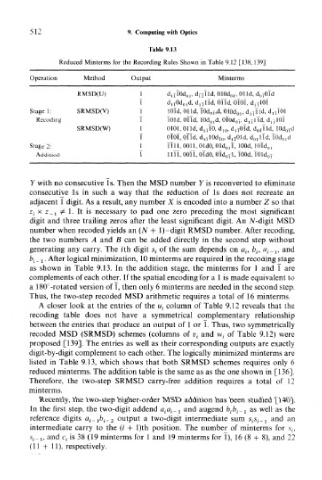Page 527 - Introduction to Information Optics
P. 527
512 9. Computing with Optics
Table 9.13
Reduced Minterms for the Recording Rules Shown in Table 9.12 [138, 139]
Operation Method Output Minterms
RMSD(U) 1 dj il0d oj, d nl Id, 010d 0 i, 01 Id, d olOTd
1 d lTOd 01d, d lTlld, Olid, OM, d lT10T
Stage i: SRMSD(V) 1 I Old, Olid, 10d oT ,d, 010d 01 , d lTlld, djjTOl
Receding T lOld, Olid, 10d 01d, OTOdoi, d, TlTd, d, T10l
SRMSD(W) 1 0101, Olid, djjlO, d 10, dijOld, d oTTld, 10d ()I d
I OM, Olid, d lT10d Jo, d lT01d, d 0jlld, T0d 01d
Stage 2: 1 TTl 1, 0011, OldO, Old 01l, lOOd, I0ld 0 ,
Addition I 1 111, 001 1, OldO, 01d oT 1, TOOd, T01d oT
Y with no consecutive Is. Then the MSD number Y is reconverted to eliminate
consecutive Is in such a way that the reduction of Is does not recreate an
adjacent I digit. As a result, any number X is encoded into a number Z so that
z f x z_ j ?£ 1. It is necessary to pad one zero preceding the most significant
digit and three trailing zeros after the least significant digit. An JV-digit MSD
number when recoded yields an (N 4- 1)-digit RMSD number. After receding,
the two numbers A and B can be added directly in the second step without
generating any carry. The ith digit s,- of the sum depends on a (, b t, a i^ 1, and
£,-_ i. After logical minimization, 10 minterms are required in the receding stage
as shown in Table 9.13. In the addition stage, the minterms for 1 and I are
complements of each othej. If the spatial encoding for a 1 is made equivalent to
c
a 180 -rotated version of T, then only 6 minterms are needed in the second step.
Thus, the two-step recoded MSD arithmetic requires a total of 16 minterms.
A closer look at the entries of the u t column of Table 9.12 reveals that the
receding table does not have a symmetrical complementary relationship
between the entries that produce an output of 1 or T. Thus, two symmetrically
recoded MSD (SRMSD) schemes (columns of v { and w t of Table 9.12) were
proposed [139]. The entries as well as their corresponding outputs are exactly
digit-by-digit complement to each other. The logically minimized minterms are
listed in Table 9.13, which shows that both SRMSD schemes requires only 6
reduced minterms. The addition table is the same as as the one shown in [136],
Therefore, the two-step SRMSD carry-free addition requires a total of 12
minterms.
Recently, the two-step higher-order MSD addition has been studied [140].
In the first step, the two-digit addend a ia i_ 1 and augend b ib i^ l as well as the
reference digits a i_ 1b i^ 2 output a two-digit intermediate sum s is i^ l and an
intermediate carry to the (i + l)th position. The number of minterms for s ;,
s,._i, and Cf is 38 (19 minterms for 1 and 19 minterms for T), 16 (8 + 8), and 22
(11 4- 11), respectively.

